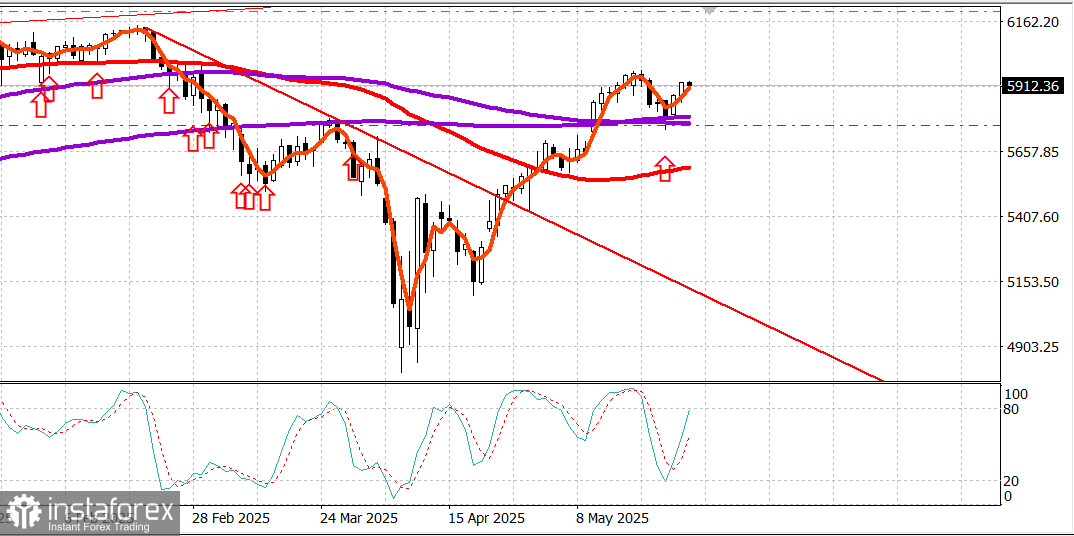
S&P500
US stock market is showing buoyant growth
Snapshot of major US stock indices on Tuesday:
- Dow Jones: +1.8%
- NASDAQ: +2.5%
- S&P 500: +2.1%
- S&P 500 at 5,921 in a range of 5,400 to 6,200
On Tuesday, sellers failed to set the tone as the stock market surged following a series of positive developments. Equities opened on an optimistic note and maintained bullish momentum throughout the session, benefiting from hesitant investors again entering the market in fear of missing out on further gains.
The stock indices closed near their intraday highs, supported by three key catalysts:
President Trump announced he would postpone the implementation of his proposed 50% tariff on EU imports until July 9, following a phone call with European Commission President Ursula von der Leyen, who reportedly wants to speed up trade negotiations.
Treasury yields pulled back, aided by reports that Japan may reduce issuance of super-long bonds. The 10-year yield dropped by 8 basis points to 4.43%, below the key 4.50% mark, while the 30-year yield fell by 10 basis points to 4.94%, dipping below 5.00%.
The Consumer Confidence Index for May jumped sharply to 98.0 (consensus: 87.0) from a revised 85.7 in April (originally 86.0), reflecting declining short-term inflation expectations from 7.0% to 6.5%.
While these were the headline drivers, sector performance told the rest of the story:
Sector performance
Top gainers:
- Consumer Discretionary: +3.0%
- Information Technology: +2.6%
- Communication Services: +2.1%
These sectors led the broad-based rally, including strong performance from large-cap and small-cap stocks.
Lagging sectors:
- Utilities: +0.8%
- Energy: +0.8%
With tariff concerns temporarily easing, hedging activity decreased, and the CBOE Volatility Index (VIX) sank by 13.6% to 19.25.
Market breadth
Buyers were in clear control:
On the NYSE, advancing stocks outnumbered decliners 6 to 1.
On the Nasdaq, the ratio was over 2 to 1 in favor of gainers.
Other key developments
The Treasury market digested a $69 billion 2-year note auction successfully.
The high yield was 3.955%, just one basis point under the 3.965% when-issued yield.
Demand was slightly below average in dollar terms.
The US dollar index (DXY) rose by 0.5% to 99.59.
Year-to-date performance:
- S&P 500: +0.7%
- Dow Jones: -0.4%
- Nasdaq: -0.6%
- S&P 400: -2.5%
- Russell 2000: -6.3%
Economic calendar on Wednesday
Durable Goods Orders for April:
Headline orders: -6.3% MoM (consensus: -8.1%)
March was revised down to +7.6% from +9.2%.
Excluding transportation: +0.2% MoM (consensus: 0.0%)
March revised to -0.2% from 0.0%.
Key takeaway: Business investment weakened, as seen in a 1.3% drop in core capital goods orders (nondefense ex-aircraft).
Housing market:
- FHFA House Price Index (March): -0.1% MoM (consensus: +0.2%)
- The index for February was revised to 0.0% from +0.1%.
- S&P Case-Shiller HPI (March): +4.1% YoY (consensus: +4.4%)
- February remained at +4.5%.
- Conference Board Consumer Confidence (May):
The index rose to 98.0 (consensus: 87.0) from a revised 85.7. It ended a streak of five straight monthly declines.
Half of the responses were collected after the May 12 announcement that the US and China would suspend mutual tariffs, which likely boosted sentiment.
Energy market
Brent crude is trading at $64.60 per barrel. Oil remains weak, failing to respond to the broader US market rally.
Crude oil is weighed down by concerns about Chinese economic weakness due to Trump's tariffs, despite recent cuts from 145% to 30%, the remaining tariff level still acts as a de facto barrier.
Conclusion
The US stock market is clearly signaling clear-cut bullish momentum, likely aiming for year-to-date highs. Investors are advised to maintain long positions and consider buying on dips, should such opportunities arise.





















